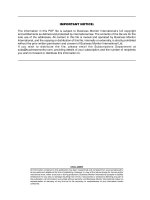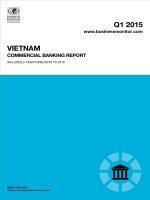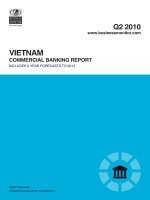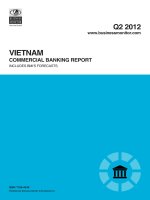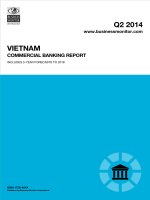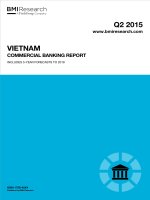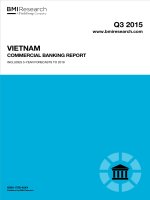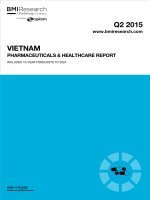Vietnam freight transport report q2 2015
Bạn đang xem bản rút gọn của tài liệu. Xem và tải ngay bản đầy đủ của tài liệu tại đây (415.49 KB, 65 trang )
Q2 2015
www.bmiresearch.com
VIETNAM
FREIGHT TRANSPORT REPORT
INCLUDES 5-YEAR FORECASTS TO 2019
ISSN 1750-5364
Published by:BMI Research
Vietnam Freight Transport Report Q2 2015
INCLUDES 5-YEAR FORECASTS TO 2019
Part of BMI’s Industry Report & Forecasts Series
Published by: BMI Research
Copy deadline: February 2015
BMI Research
Senator House
85 Queen Victoria Street
London
EC4V 4AB
United Kingdom
Tel: +44 (0) 20 7248 0468
Fax: +44 (0) 20 7248 0467
Email:
Web:
© 2015 Business Monitor International Ltd
All rights reserved.
All information contained in this publication is
copyrighted in the name of Business Monitor
International Ltd, and as such no part of this
publication may be reproduced, repackaged,
redistributed, resold in whole or in any part, or used
in any form or by any means graphic, electronic or
mechanical, including photocopying, recording,
taping, or by information storage or retrieval, or by
any other means, without the express written consent
of the publisher.
DISCLAIMER
All information contained in this publication has been researched and compiled from sources believed to be accurate and reliable at the time of
publishing. However, in view of the natural scope for human and/or mechanical error, either at source or during production, Business Monitor
International Ltd accepts no liability whatsoever for any loss or damage resulting from errors, inaccuracies or omissions affecting any part of the
publication. All information is provided without warranty, and Business Monitor International Ltd makes no representation of warranty of any kind
as to the accuracy or completeness of any information hereto contained.
Vietnam Freight Transport Report Q2 2015
INCLUDES 5-YEAR FORECASTS TO 2019
Part of BMI’s Industry Report & Forecasts Series
Published by: BMI Research
Copy deadline: February 2015
BMI Research
Senator House
85 Queen Victoria Street
London
EC4V 4AB
United Kingdom
Tel: +44 (0) 20 7248 0468
Fax: +44 (0) 20 7248 0467
Email:
Web:
© 2015 Business Monitor International Ltd
All rights reserved.
All information contained in this publication is
copyrighted in the name of Business Monitor
International Ltd, and as such no part of this
publication may be reproduced, repackaged,
redistributed, resold in whole or in any part, or used
in any form or by any means graphic, electronic or
mechanical, including photocopying, recording,
taping, or by information storage or retrieval, or by
any other means, without the express written consent
of the publisher.
DISCLAIMER
All information contained in this publication has been researched and compiled from sources believed to be accurate and reliable at the time of
publishing. However, in view of the natural scope for human and/or mechanical error, either at source or during production, Business Monitor
International Ltd accepts no liability whatsoever for any loss or damage resulting from errors, inaccuracies or omissions affecting any part of the
publication. All information is provided without warranty, and Business Monitor International Ltd makes no representation of warranty of any kind
as to the accuracy or completeness of any information hereto contained.
Vietnam Freight Transport Report Q2 2015
CONTENTS
BMI Industry View ............................................................................................................... 7
SWOT .................................................................................................................................. 10
Freight Transport .................................................................................................................................... 10
Political ................................................................................................................................................. 12
Economic ............................................................................................................................................... 13
Operational Risk ..................................................................................................................................... 15
Industry Forecast .............................................................................................................. 17
Road Freight ......................................................................................................................................... 20
Table: Road Freight (Vietnam 2012-2019) . . . . . . . . . . . . . . . . . . . . . . . . . . . . . . . . . . . . . . . . . . . . . . . . . . . . . . . . . . . . . . . . . . . . . . . . . . . . . . . . . . . . . . . . . . . . . . . . . . . . . . . . . . . . . 21
Inland Waterways .................................................................................................................................. 21
Table: Inland Waterway Freight (Vietnam 2012-2019) . . . . . . . . . . . . . . . . . . . . . . . . . . . . . . . . . . . . . . . . . . . . . . . . . . . . . . . . . . . . . . . . . . . . . . . . . . . . . . . . . . . . . . . . . . . . . . . . 23
Rail Freight .......................................................................................................................................... 23
Table: Vietnam Transport Network . . . . . . . . . . . . . . . . . . . . . . . . . . . . . . . . . . . . . . . . . . . . . . . . . . . . . . . . . . . . . . . . . . . . . . . . . . . . . . . . . . . . . . . . . . . . . . . . . . . . . . . . . . . . . . . . . . . . . 24
Table: Rail Freight (Vietnam 2012-2019) . . . . . . . . . . . . . . . . . . . . . . . . . . . . . . . . . . . . . . . . . . . . . . . . . . . . . . . . . . . . . . . . . . . . . . . . . . . . . . . . . . . . . . . . . . . . . . . . . . . . . . . . . . . . . . 25
Air Freight ............................................................................................................................................ 25
Table: Air Freight (Vietnam 2012-2019) . . . . . . . . . . . . . . . . . . . . . . . . . . . . . . . . . . . . . . . . . . . . . . . . . . . . . . . . . . . . . . . . . . . . . . . . . . . . . . . . . . . . . . . . . . . . . . . . . . . . . . . . . . . . . . . 27
Maritime Freight ................................................................................................................................... 27
Table: Maritime Freight (Vietnam 2012-2019) . . . . . . . . . . . . . . . . . . . . . . . . . . . . . . . . . . . . . . . . . . . . . . . . . . . . . . . . . . . . . . . . . . . . . . . . . . . . . . . . . . . . . . . . . . . . . . . . . . . . . . . . . 28
Trade ................................................................................................................................................... 29
Table: Trade Overview (Vietnam 2012-2019) . . . . . . . . . . . . . . . . . . . . . . . . . . . . . . . . . . . . . . . . . . . . . . . . . . . . . . . . . . . . . . . . . . . . . . . . . . . . . . . . . . . . . . . . . . . . . . . . . . . . . . . . . . 29
Table: Key Trade Indicators (Vietnam 2012-2019) . . . . . . . . . . . . . . . . . . . . . . . . . . . . . . . . . . . . . . . . . . . . . . . . . . . . . . . . . . . . . . . . . . . . . . . . . . . . . . . . . . . . . . . . . . . . . . . . . . . . 29
Table: Top Import Destinations, 2006-2013 . . . . . . . . . . . . . . . . . . . . . . . . . . . . . . . . . . . . . . . . . . . . . . . . . . . . . . . . . . . . . . . . . . . . . . . . . . . . . . . . . . . . . . . . . . . . . . . . . . . . . . . . . . . . 31
Table: Top Export Destinations, 2006-2013 . . . . . . . . . . . . . . . . . . . . . . . . . . . . . . . . . . . . . . . . . . . . . . . . . . . . . . . . . . . . . . . . . . . . . . . . . . . . . . . . . . . . . . . . . . . . . . . . . . . . . . . . . . . . 32
Market Overview ............................................................................................................... 33
Company Profile ................................................................................................................ 41
Vietnam Airlines Cargo ............................................................................................................................ 41
Political Outlook ................................................................................................................ 44
Domestic Politics ..................................................................................................................................... 44
Table: Vietnam Political Overview . . . . . . . . . . . . . . . . . . . . . . . . . . . . . . . . . . . . . . . . . . . . . . . . . . . . . . . . . . . . . . . . . . . . . . . . . . . . . . . . . . . . . . . . . . . . . . . . . . . . . . . . . . . . . . . . . . . . . 44
Long-Term Political Outlook ..................................................................................................................... 45
Oil Price Outlook ............................................................................................................... 49
Global - Crude Oil, Refined Fuels And Natural Gas Prices, 10-year Forecasts .................................................... 49
Table: Energy Price Forecasts (Global 2013-2018) . . . . . . . . . . . . . . . . . . . . . . . . . . . . . . . . . . . . . . . . . . . . . . . . . . . . . . . . . . . . . . . . . . . . . . . . . . . . . . . . . . . . . . . . . . . . . . . . . . . 49
Table: Energy Price Forecasts (Global 2019-2024) . . . . . . . . . . . . . . . . . . . . . . . . . . . . . . . . . . . . . . . . . . . . . . . . . . . . . . . . . . . . . . . . . . . . . . . . . . . . . . . . . . . . . . . . . . . . . . . . . . . 50
Macroeconomic Forecasts ............................................................................................... 52
Expecting Sustained Growth Momentum In 2015 ........................................................................................... 52
© Business Monitor International Ltd
Page 4
Vietnam Freight Transport Report Q2 2015
Table: Economic Activity (Vietnam 2009-2018) . . . . . . . . . . . . . . . . . . . . . . . . . . . . . . . . . . . . . . . . . . . . . . . . . . . . . . . . . . . . . . . . . . . . . . . . . . . . . . . . . . . . . . . . . . . . . . . . . . . . . . . . 56
Demographic Forecast ..................................................................................................... 57
Table: Population Headline Indicators (Vietnam 1990-2025) . . . . . . . . . . . . . . . . . . . . . . . . . . . . . . . . . . . . . . . . . . . . . . . . . . . . . . . . . . . . . . . . . . . . . . . . . . . . . . . . . . . . . . . . . 58
Table: Key Population Ratios (Vietnam 1990-2025) . . . . . . . . . . . . . . . . . . . . . . . . . . . . . . . . . . . . . . . . . . . . . . . . . . . . . . . . . . . . . . . . . . . . . . . . . . . . . . . . . . . . . . . . . . . . . . . . . . . 58
Table: Urban/Rural Population & Life Expectancy (Vietnam 1990-2025) . . . . . . . . . . . . . . . . . . . . . . . . . . . . . . . . . . . . . . . . . . . . . . . . . . . . . . . . . . . . . . . . . . . . . . . . . . . . 59
Table: Population By Age Group (Vietnam 1990-2025) . . . . . . . . . . . . . . . . . . . . . . . . . . . . . . . . . . . . . . . . . . . . . . . . . . . . . . . . . . . . . . . . . . . . . . . . . . . . . . . . . . . . . . . . . . . . . . . 59
Table: Population By Age Group % (Vietnam 1990-2025) . . . . . . . . . . . . . . . . . . . . . . . . . . . . . . . . . . . . . . . . . . . . . . . . . . . . . . . . . . . . . . . . . . . . . . . . . . . . . . . . . . . . . . . . . . . . 60
Methodology ...................................................................................................................... 62
Industry Forecast Methodology ................................................................................................................ 62
Sector-Specific Methodology .................................................................................................................... 63
Sources ................................................................................................................................................ 64
© Business Monitor International Ltd
Page 5
Vietnam Freight Transport Report Q2 2015
BMI Industry View
The Vietnamese economy is set to perform strongly in 2015, due to continued strong foreign direct
investment (FDI), healthy export growth and ongoing efforts by the government to improve macroeconomic
fundamentals. In turn, the country's freight industry is set to benefit as a result.
In line with our bullish economic outlook for Vietnam, the country's real GDP growth accelerated to an
impressive 7.0% in Q4 2014 from the revised 6.1% in the previous quarter. This in turn brought real GDP
expansion for the year to 6.0%, surpassing the Bloomberg consensus estimate of 5.7% and marking
Vietnam as one of the brightest growth spots in Asia. With that in mind, it is perhaps unsurprising that the
Vietnamese freight industry is set to record healthy growth over the short and medium term.
Our forecasts are relatively unchanged from last quarter, and will see Vietnam's freight modes remain
healthy across the board. Road freight will be the outperformer in terms of year-on-year (y-o-y) at 6.00%,
while the rail and air freight modes are set to see the same level of growth in 2015 (3.40%). The Vietnamese
ports sector will also once again see strong annual growth in terms of tonnage handled.
Headline Industry Data
■
2015 rail freight tonnage is set to increase by 3.40% to 6.96mn tonnes.
■
2015 air freight tonnage is forecast to rise by 3.40% to 195,640 tonnes.
■
Tonnage handled at the port of Ho Chi Minh City in 2015 is forecast to grow 7.61%, whereas tonnage
handled at the port of Da Nang is forecast to increase 6.50%.
■
2015 road freight tonnage is forecast to grow by 6.00% to 860.08mn tonnes.
■
2015 total trade is forecast to rise by 6.65%.
Key Industry Trends
Major Growth Market For Air Cargo Operators: We believe that the air cargo market in Vietnam will
expand rapidly in the medium-term (2015-2019) as the country's manufacturing sector diversifies into
electronics and higher value goods production. Korean electronics giant Samsung is expanding its
manufacturing interests in Vietnam and plans to utilise air freight as the main transport mode to export
finished products. This strategy is highlighted by the company's plan to operate its own air cargo terminal to
handle goods at Hanoi's Noi Bai International Airport, set to open in late 2015.
© Business Monitor International Ltd
Page 7
Vietnam Freight Transport Report Q2 2015
Vietjet Air Cargo To Invest In Freighters: Vietjet Air Cargo, an affiliate company of Vietnam-based
Vietjet Air, intends to invest in B737 freighters and A330-200Fs to expand its global network and become
a major cargo carrier in the Asia region. The company aims to expand its fleet size to 20 A320s by the end
of 2014. The new aircrafts will be wet-leased in the first year and dry-leased in the second year, according
to Vietjet Air Cargo CEO Do Xuan Quang. The company is also looking at airline partnership opportunities
for long haul routes, reported The Loadstar.
Impressive Box Growth To Continue In 2015: The port of Ho Chi Minh City is well placed to continue its
impressive container throughput growth picture in 2015, albeit at a slightly slower rate than 2014. Over the
next 12 months, box throughput will lead the way compared to tonnage throughput at the port (8.00%
compared to 7.61%). This follows 2014's container throughput gains of 10.00% and tonnage throughput
increase of 7.74%. We are likely to see box throughput reach 4.99mn twenty-foot equivalent units (TEUs)
by the end of 2015, while tonnage throughput handled will reach 44.99mn tonnes in the same timeframe.
Key Risks To Outlook
The new international terminal at Hanoi Airport should offer significant upside risk in the future, once the
facility is up and running. Operations are set to commence at the new USD645mn passenger terminal
at Hanoi Airport, Vietnam. The first services using the terminal will take place on December 31 2014.
Around 99% of the terminal construction has now been completed and the contractor has met the progress
and quality targets set for the project. The new facility will operate as an international air terminal, with 96
check-in counters, 17 boarding gates, 10 self-service kiosks and 283 flight information display systems. The
facility is 996m long and has 139,000sq m total gross floor area. The airport has plans to construct an
additional two terminals as it attempts to boost capacity to 50mn passengers a year, while the freight sphere
should also benefit.
In other good news for the Vietnamese freight industry, Vietnam and South Korea have concluded
negotiations for a bilateral free trade agreement (FTA) during a meeting between Vietnamese Prime
Minister Nguyen Tan Dung and South Korean President Park Geun-hye on the sidelines of the ASEANKorea Commemorative Summit. The FTA seeks to triple bilateral trade turnover to USD70bn by 2020. The
FTA covers 17 areas, including products, services and investment and intellectual property; however, it
excludes rice, a sensitive product for Korean farmers, as reported by the Korea Times. The two Asian
nations have held nine rounds of FTA talks since August 2012, reported Thanh Nien News.
However, downside risks do hover over the shipping sector going forward. Shipping companies operating in
South East Asia are exposed to elevated security risks following the deadly escalation in pirate activity in
© Business Monitor International Ltd
Page 8
Vietnam Freight Transport Report Q2 2015
the region. The deteriorating security situation in South East Asian waters heightens risks for shipping
companies, their employees, insurance firms, and global trade. A Vietnam flagged tanker, the M/T VP
Asphalt 2, was attacked by pirates, southeast of Pulau Aur, Malaysia in the South China Sea, on December
7 2014. The Vietnam-bound tanker was carrying 16 Vietnamese crew members and 2,300 tonnes of
bitumen when it was seized by seven armed pirates as the ship made its way from Singapore. The pirates
proceeded to tie up crew members, with one of the crew being shot, before stealing personal possessions
and escaping. The crewman died later that day from his injuries.
© Business Monitor International Ltd
Page 9
Vietnam Freight Transport Report Q2 2015
SWOT
Freight Transport
Vietnam Freight Transport Industry SWOT Analysis
Strengths
■
Vietnam's strong domestic growth rate, coupled with its geography - it stretches for
thousands of kilometres on a north-south axis - creates a need for long-distance
freight haulage.
■
A recovery of activity levels at the nation's ports in 2010 is expected to continue over
the mid-term to 2018.
■
Vietnam's location on the South China Sea gives the country access to the main interAsian shipping routes, as well as access to the developing land transport links with
ASEAN countries, allowing the country scope to develop its trade logistics.
Weaknesses
■
The generally poor state of the road network. Despite new highway construction, only
13.5% of the network is considered to be in good condition. Just 26% of the network
has two or more lanes and only 29% is tarred.
■
Traditionally low investment in rail, with the potential for cost-effective bulk rail freight
being underutilised.
■
Decades of under-investment have left the country with a port infrastructure system
that is poor by international standards.
■
Overcapacity is a growing problem.
■
Unresolved business environment issues and lack of significant improvement in
access to infrastructure financing means that we remain very conservative on the
growth potential of Vietnam's freight sector.
■
A slowdown affecting the US economy has a knock-on effect on Vietnam due to it
being the Asian country's largest export partner.
Opportunities
■
The beginnings of local commercial vehicle production, which will help improve the
stock of lorries used by road haulage companies.
© Business Monitor International Ltd
Page 10
Vietnam Freight Transport Report Q2 2015
Vietnam Freight Transport Industry SWOT Analysis - Continued
■
Chinese investment could bring about much-needed improvements in the rail sector.
■
Growing international interest in Vietnam as a growth market within the box shipping
sector.
■
The World Bank stated at the start of 2014 that improved infrastructure could improve
the country's economy substantially.
■
Vietnamese Transport Minister Dinh La Thang wishes to see the government help
boost inland waterway facilities and has been formulating policies likely to attract
investments in the sector.
Threats
■
Vietnam risks losing out to neighbouring countries if it is unable to develop its
infrastructure to keep up with the pace of demand.
■
Vietnam is vulnerable to any slowdown in Chinese investment and to political risk in
the sensitive South China Sea, subject to competing sovereignty claims.
■
A drop in international demand for exports would negatively affect Vietnam's freight
transport sector.
© Business Monitor International Ltd
Page 11
Vietnam Freight Transport Report Q2 2015
Political
SWOT Analysis
Strengths
■
The Communist Party of Vietnam remains committed to market-oriented reforms and
we do not expect major shifts in policy direction over the next five years. The oneparty system is generally conducive to short-term political stability.
■
Relations with the US have witnessed a marked improvement, and Washington sees
Hanoi as a potential geopolitical ally in South East Asia.
Weaknesses
■
Corruption among government officials poses a major threat to the legitimacy of the
ruling Communist Party.
■
There is increasing (albeit still limited) public dissatisfaction with the leadership's tight
control over political dissent.
Opportunities
■
The government recognises the threat corruption poses to its legitimacy, and has
acted to clamp down on graft among party officials.
■
Vietnam has allowed legislators to become more vocal in criticising government
policies. This is opening up opportunities for more checks and balances within the
one-party system.
Threats
■
Although strong domestic control will ensure little change to Vietnam's political scene
in the next few years, over the longer term, the one-party-state will probably be
unsustainable.
■
Relations with China have deteriorated over recent years due to Beijing's more
assertive stance over disputed islands in the South China Sea and domestic criticism
of a large Chinese investment into a bauxite mining project in the central highlands,
which could potentially cause wide-scale environmental damage.
© Business Monitor International Ltd
Page 12
Vietnam Freight Transport Report Q2 2015
Economic
SWOT Analysis
Strengths
■
Vietnam has been one of the fastest-growing economies in Asia in recent years, with
GDP growth averaging 6.6% annually between 2000 and 2013.
■
The economic boom has lifted many Vietnamese out of poverty, with the official
poverty rate in the country falling from 58% in 1993 to 17.2% in 2012.
■
Vietnam has been strengthening its trade and aid ties in a bid to increase exports and
diversify its export sector.
Weaknesses
■
Vietnam still suffers from fiscal deficits, leaving the economy vulnerable to global
economic uncertainties. The fiscal deficit is dominated by substantial spending on
social subsidies that could be difficult to withdraw.
■
The heavily-managed and weak currency reduces incentives to improve quality of
exports, and also keeps import costs high, contributing to inflationary pressures.
Opportunities
■
WTO membership and the upcoming ASEAN economic integration in 2015 should
give Vietnam greater access to both foreign markets and capital, while making
Vietnamese enterprises stronger through increased foreign competition.
■
The government has continued to move forward with market reforms, including
privatisation of state-owned enterprises, addressing the high level of bad loans in the
banking sector as well as liberalising the banking sector.
■
Urbanisation will continue to be a long-term growth driver. The UN forecasts the
urban population rising from 32% of the population in 2013 to more than 50% by the
early 2040s.
Threats
■
Although inflation has subsided in 2014, complacency by the State Bank of Vietnam
on this front could result in a decline in investment.
■
The potential for an escalation of political tensions with China over sovereign claims
to parts of the South China Sea could have a negative impact on the economy.
© Business Monitor International Ltd
Page 13
Vietnam Freight Transport Report Q2 2015
SWOT Analysis - Continued
■
Market reforms could progress at a much slower pace as the government remains
cautious about ceding ownership to foreign investors.
© Business Monitor International Ltd
Page 14
Vietnam Freight Transport Report Q2 2015
Operational Risk
SWOT Analysis
Strengths
■
Vietnam has a high number of university graduates with skilled degrees and a high
literacy rate for its income level.
• In addition to a number of regional and international flight options, Vietnam has an
extensive inland waterway system.
■
Strong contract enforcement capabilities increase security.
• Vietnam's rate of violent crime is generally low, and foreigners are unlikely to be
targeted.
Weaknesses
■
High labour costs increase overall operating costs, and difficulty in hiring foreigners
creates shortages of skilled labour.
• Underdeveloped rail capacity overburdens the road network.
• One of the worst tax administration systems in Asia.
• The police force is under-equipped and under-resourced in many areas.
Opportunities
■
Fairly high expenditures in secondary education by regional standards will help close
gaps in access to education.
• Vietnam is easily accessible from the main shipping routes, and growth in the number
of port facilities will provide adequate capacity.
• Declining trade barriers are making it easier to enter the market.
• Increased foreign participation in the banking sector will increase the availability of
funds for loans.
Threats
■
Unequal access to secondary education will result in a lower-quality workforce in
poorer regions.
• Vietnam's reliance on imported oil poses risks in the form of energy and fuel
shortages.
© Business Monitor International Ltd
Page 15
Vietnam Freight Transport Report Q2 2015
SWOT Analysis - Continued
• Corruption and inefficiency in the legal system.
• Anti-Chinese violence, as seen in May 2014, could be a harbinger of wider political
and social unrest.
© Business Monitor International Ltd
Page 16
Vietnam Freight Transport Report Q2 2015
Industry Forecast
BMI View: We anticipate the Vietnamese freight industry will enjoy a healthy rate of tonnage growth in
2015. From an expenditure approach, the strong showing in 2014 is due largely to high foreign investor
interest towards the country and the robust performance in the export sector, which are both buoying the
freight mix in the country. Latest data published by the General Statistics Office showed that total foreign
registered capital rose 9.6% to USD15.6bn in 2014, with the manufacturing sector receiving the bulk of it
(71.6%).
While there is the potential for volatility in emerging and frontier markets as the US looks to tighten its
monetary policy over the coming quarters, we nevertheless expect a continuation of strong FDI inflows to
Vietnam. This is corroborated by our view that Vietnam can continue to attract foreign investors,
particularly manufacturing firms, as it offers them attractively low wages, strong demographics that will
ensure a continual supply of workers as well as generous tax incentives.
Meanwhile, exports grew by 8.7% to approximately USD149.1bn over the course of 2014. Given the
country's export orientation to the US, which received about 19% of total Vietnamese outbound shipments
in 2014, a recovering US economy will bode well for the export sector going forward.
There is slight downside risk on the horizon however, due to tense relations at the time of writing between
Vietnam and key trade partner China, which could have a slight detrimental impact on Vietnam's freight
sector. We believe slowing growth in the country's manufacturing sector has likely been due to China's
deployment of an oil rig in disputed waters off Vietnam's coast in May, which sparked an outbreak of antiChina violent protests in Vietnam.
Several Chinese factories were damaged, while others were forced to shut down during the riot, affecting
manufacturing orders as a result. With the Vietnamese government acting fast to stop a further escalation of
violence, coupled with China's removal of its oil rig in July, renewed political stability in Vietnam will
allow its resilient manufacturing sector to continue performing well. This will bode well for the gradual
pick-up in growth momentum in the Vietnamese economy.
© Business Monitor International Ltd
Page 17
Vietnam Freight Transport Report Q2 2015
GDP To Enjoy Healthy Medium Term
Real GDP growth, % change y-o-y (2001-2019)
8
7
6
2019f
2018f
2017f
2016f
2015f
2014
2013
2012
2011
2010
2009
2008
2007
2006
2005
2004
2003
2002
2001
5
Vietnam - Real GDP growth, % y-o-y
e/f = BMI estimate/forecast. Source: Asian Development Bank, General Statistics Office, BMI.
To keep pace with growth, Vietnam will need to invest in its logistics sector, but BMI expects a lot of this
investment to come from outside logistic and freight transport companies, which will be keen to enter and
expand into this high-growth market. We believe that rapid urbanisation, driven by a healthy pipeline of
government-led infrastructure projects over the next five years, will continue to spur rural-urban migration
and foreign direct investment (FDI) into developed cities such as Ho Chi Minh and Hanoi. We have also
already witnessed this to some extent in Vietnam's port sector, with considerable investment being made by
container shipping lines and global port operators in the development of modern box terminals at Vietnam's
ports.
This investment in the country's maritime sector has ensured that Vietnam's manufacturing growth can be
achieved with greater links between the country and its main export partner the US. Direct container
shipping links between Vietnam and the US have been in operation since 2009, which have cut both time
and cost, as previously Vietnamese shipments had to be transhipped via Singapore.
Demand from the US for Vietnam's manufactured goods looks set to continue growing, with Vietnam's
exports set to benefit from the slow but steady recovery in the US economy.
© Business Monitor International Ltd
Page 18
Vietnam Freight Transport Report Q2 2015
Vietnam's export outlook will also continue to be bolstered by China's growth outlook. Although we project
China's economic growth to slow over the medium term, the country's real GDP growth outlook does
remain robust.
Vietnam plays a key role in China's coal supply chain. Vietnam is China's fifth-largest coal supplier
providing the country with the thermal coal it requires for its power stations. Vietnam's role in this supply
chain looks set to continue, although BMI highlights that China is trying to decrease its power sectors'
reliance on coal. While we believe that the percentage supplied by coal fired power plants within China's
overall energy mix will slip over the medium term, it will nevertheless remain above 70%.
BMI believes that Vietnam's textile sector will also benefit from the development of China's middle class,
as the country starts to import more from abroad.
Meanwhile, the proposed Trans-Pacific Partnership (TPP), which is a regional free-trade agreement being
negotiated by 12 countries in the Asia Pacific region: Australia, Brunei, Canada, Chile, Japan, Malaysia,
Mexico, New Zealand, Peru, Singapore, the US and Vietnam. Speaking to Tuoi Tre (Youth) newspaper in
January 2015, Ginny Foote, president and chief executive of Bay Global Strategies specializing in economic
management consultation, said: 'I really hope that the TPP will be signed in six months. But it is difficult to
predict because there are 12 member countries participating in the TPP, and each country has a different
political background and different difficulties. The important thing now is that we should be ready for it.'
Bad news for investment prospects in the freight sphere arrive due to foreign investors having to wait for at
least 10 months for the government to ease restrictions on overseas shareholders, following the shelving of a
2013 proposal to raise ownership limits. According to Vu Bang, chairman of the State Securities
Commission (SSC), policy makers must amend a plan by the Ministry of Finance that suggested increasing
the foreign ownership limits on voting shares in a few industries from 49% to 60%. The SSC will work with
the respective ministries to modify the plan and deal with inconsistencies with the current laws, according to
the SSC's chairman. Bang stated that a rise in foreign limits will be eventually implemented; however, he
refused to give details of the new proposal. Prime Minister Nguyen Tan Dung will need to grant approval to
the plan (Bloomberg).
© Business Monitor International Ltd
Page 19
Vietnam Freight Transport Report Q2 2015
Road Freight
Road Dominates And Offers Best Links Into China
Despite its low standing in road infrastructure, with the Global Economic Forum's Competitiveness Report
2014/15 ranking Vietnam's roads a very poor 127 out of 142 globally, and placing it last in comparison with
13 of its Asia peers, the country's logistics needs are, nonetheless, primarily met by road. In 2015 and
beyond, we predict that road freight volumes in Vietnam will account for the majority of freight carried in
the country.
In 2015, we have maintained last quarter's forecast that year-on-year (y-o-y) tonnage throughput growth
will come in at 6.00%, which is a healthy rate, but down slightly on 2014's estimated annual growth of
6.06%. That said, the heady heights of 2012's double-digit growth will not be achieved over the medium
term. This scenario would see tonnage handled reach 860.1mn tonnes by the end of 2015. Over our forecast
period to 2019, we predict average annual growth to come in at 6.94%.
There is, however, upside risk to this forecast as more foreign logistics companies, with considerable road
freight expertise, expand in Vietnam. Both FedEx and DHL have expanded their role in Vietnam in recent
times. While some companies are breaking into Vietnam by developing their own operations in the country,
others are getting a head start by acquiring and joining up with domestic freight operators. This is the route
CEVA Logistics has taken entering into a joint venture with its long-term business partner Indo Trans
Logistics Group.
Road freight plays a key role not only in Vietnam's domestic logistics sector, but also in the country's export
supply chain. Road is the main form of transport linking Vietnam's factories to the country's ports and also
plays a key role in linking Vietnam with its second-largest export partner China.
Vietnam's northern border links the country with the south of China. Road links continue to be developed
between the two and with them trucking services. Kerry Asia Road Transport (Kart), for example, offers
a twice-weekly trucking link connecting Shenzhen and Hanoi.
© Business Monitor International Ltd
Page 20
Vietnam Freight Transport Report Q2 2015
Table: Road Freight (Vietnam 2012-2019)
2012
2013
2014e
2015f
2016f
2017f
2018f
2019f
722,156.40
765,070.40
811,395.88
860,079.63
915,984.81
980,103.74
1,055,150.77
1,134,940.86
Road
freight
tonnes,
% y-o-y
10.40
5.94
6.06
6.00
6.50
7.00
7.66
7.56
Road
freight
tonneskm (mn
ton km)
43,902.40
46,790.70
50,093.61
53,800.54
57,996.98
62,660.95
67,558.72
72,766.04
Road
freight
tonneskm, %
y-o-y
9.40
6.58
7.06
7.40
7.80
8.04
7.82
7.71
Road
Freight
Tonnes
(000)
e/f = BMI estimate/forecast. Source: General Statistics Office of Vietnam
Inland Waterways
Mekong Offers Trade Links With Neighbours
Vietnam's inland waterways play a considerable role in the country's freight transport sector, making it the
second-largest freight transport mode in the country. In 2015, we once more anticipate a healthy growth
picture with gains of 6.34% expected (maintaining last quarter's forecast), which will be slightly down on
2014's estimated y-o-y growth of 6.68% to reach 192.89mn tonnes. Over our forecast period, we anticipate
average annual growth of 6.25%.
© Business Monitor International Ltd
Page 21
Vietnam Freight Transport Report Q2 2015
Mekong Offers Trade Connections
Map Of The Mekong River
Source: BMI
Vietnam's inland waterways stretch for 47,130km and the country's dense network of waterways ranks its
seventh in the world in terms of length. The country's inland waterways include the Mekong River, which
enables freight connections with Vietnam's neighbours. Although we highlight that the River's full potential
has not been reached and so development in the River is an area for potential investment.
© Business Monitor International Ltd
Page 22
Vietnam Freight Transport Report Q2 2015
Table: Inland Waterway Freight (Vietnam 2012-2019)
2012
2013
2014e
2015f
2016f
2017f
2018f
2019f
Inland
Waterway
Freight
Tonnes
(000)
168,493.00
180,812.70
192,886.88
205,112.82
218,092.49
231,697.58
245,984.72
261,174.82
Inland
waterway
freight
tonnes, %
y-o-y
5.20
7.31
6.68
6.34
6.33
6.24
6.17
6.18
Inland
Waterway
freight
tonnes-km
(mn ton
km)
37,018.30
39,344.40
42,365.17
45,614.18
49,063.50
52,679.03
56,475.80
60,512.54
Inland
Waterway
freight
tonnes-km
% y-o-y
7.70
6.28
7.68
7.67
7.56
7.37
7.21
7.15
e/f = BMI estimate/forecast. Source: General Statistics Office of Vietnam
Rail Freight
Rail Network Still Lacking
Despite rail's potential as an overland trade link for Vietnam with its three neighbours, the mode's role in the
country's freight transport sector remains small. In 2014, we estimate that Vietnam's rail freight volumes
accounted for a negligible percentage of the total with the country's rail network transporting just 6.73mn
tonnes of freight.
However, the Vietnam Railway Administration is attempting to persuade the country's Transport Ministry
to appraise and approve a USD10bn plan to upgrade the North-South railway in the country, it was reported
at the end of November 2014. The move would be long overdue and provide major upside risk to our
forecasts.
In 2015 we forecast the rail freight sector to increase by 3.40%, a figure we expect to rise again to 3.70% in
2016. Positive growth has been lacking from this sector over recent years, but is set to return at least over
our forecast period, with an average annual growth of 4.00% pencilled in between 2015 and 2019.
© Business Monitor International Ltd
Page 23
Vietnam Freight Transport Report Q2 2015
There are two key factors that we believe have held back Vietnam's rail freight development and will
continue to do so.
Table: Vietnam Transport Network
Length (km)
Road
206,633
Railway
2,632
Inland Waterway
47,130
Source: CIA World Factbook (accessed January 21 2014)
The first is the quality of Vietnam's railway infrastructure. The World Economic Forum's Global
Competitiveness Report 2014/15 gives Vietnam's rail infrastructure a very low ranking, placing it 99th
globally out of 123 countries measured. A major problem for Vietnam's rail freight development is the
relative shortness of the country's rail network. Vietnam's railway lines extend for just 2,632km; this
compares with the country's 206,633km network of roads and 47,130km network of inland waterways.
The second drawback for freight rail development in Vietnam is its gauge incompatibility with China.
Vietnam's network is dominated by narrow gauge, which accounts for 80% of the total. While the country
has some standard gauge track, this system only accounts for 20% of the total.
This means that rail freight trade between Vietnam and China is slowed by gauge changes, making road
freight a more cost- and time-effective alternative; this stymies potential rail-freight projects between the
two nations.
BMI highlights that developments in Vietnam's rail network are taking place, but these have been focused
on expanding the country's passenger network (e.g., a planned high-speed railway link between Vietnam
and Laos).
We do see upside risk presenting itself by the news reported in December 2014 by International Railway
Journal that China had 'marked the completion of a key international rail project in its southern Yunnan
province on December 1 with the opening of a 142km line from Mengzi to Hekou on the border with
Vietnam'.
© Business Monitor International Ltd
Page 24
